Habsburg Monarchy

Habsburg Monarchy

Habsburg Monarchy Habsburgermonarchie | |
|---|---|
| 1282–1918 | |
 The Habsburg Monarchy in 1789 | |
| Status | Part of the Holy Roman Empire (partly) Personal union |
| Capital |
|
| Main languages | Latin, Germanb, Hungarian, Czech, Croatian, Romanian, Slovak, Slovene, Dutch, Lombard, Venetian, Friulian, Ladin, Italian, Polish, Ruthenian, Serbian, French |
| Religion | Official: Roman Catholic Recognized: Calvinism, Lutheranism, Orthodox Christianity, Judaism, Utraquisma |
| Government | Feudal Monarchy |
| Monarch | |
• 1282–1308 | Albert I of Germany and Rudolph II of Austria |
• 1916-1918 | Charles I of Austria-Hungary |
| State Chancellor | |
• 1753–1793 | Wenzel Anton |
| Historical era | Early modern/Napoleonic |
• Diet of Augsburg assigns Duchy of Austria to the Habsburgs. | December 1282 |
• Battle of Vienna | 14 July 1683 |
• War of Succession | 1740–1748 |
• Austro–Turkish War | 1787–1791 |
• Treaty of Sistova | 4 August 1791 |
• Austrian Empire declared | 11 August 1804 |
• Ausgleich | 29 May 1867 |
• Aster Revolution | 31 October 1918 |
^aMain religion of the Czech people, in the Kingdom of Bohemia recognized until 1627 when it was forbidden. ^bGerman replaced Latin as the official language of the Empire in 1784.[1] | |
Habsburg Monarchy (or Habsburg Empire) is an umbrella term used by historians for the lands and kingdoms of the House of Habsburg, especially for those of the Austrian branch. Although from 1438 until 1806 (with the exception of 1742–1745) the head of the House of Habsburg was also Holy Roman Emperor, the empire itself is not considered a part of the Habsburg Monarchy.
The formation of the Habsburg Monarchy began with the election of Rudolf I as King of Germany in 1273 and his acquisition of the Duchy of Austria for his house in 1282. In 1482, Maximilian I acquired the Netherlands through marriage. Both these territories lay within the Empire. His nephew and successor, Charles V, inherited also Spain and its colonies in 1516 and ruled the Habsburg Empire at its greatest territorial extent. The abdication of Charles V in 1556 led to a broad division of the Habsburg holdings between his brother Ferdinand I, who was his deputy in the Austrian lands since 1521 and the elected king of Hungary and Bohemia since 1526, and his son Philip II of Spain. The Spanish branch (which also held the Netherlands, Burgundy and lands in Italy) went extinct in 1700. The Austrian branch (which also had the Imperial throne and ruled Hungary, Bohemia and all the crowns entailed to them) was itself divided between different branches of the family from 1564 until 1665, but thereafter it remained a single personal union.
The Habsburg monarchy was thus a composite monarchy - with no single constitution or shared institutions outside of the Habsburg court itself - composed of territories within and outside the Holy Roman Empire, united only in the person of the monarch. The dynastic composite entities were the most common / dominant on the European continent in the early modern era.[2] [3] This gradually changed in the early 19th century. From 1804 to 1867 the Habsburg Monarchy was formally unified as the Austrian Empire, and from 1867 to 1918 as the Austro-Hungarian Empire.[4][5]It collapsed following defeat in the First World War.
In historiography, the Habsburg Monarchy (of the Austrian branch) is often called "Austria" by metonymy. Around 1700 the term monarchia austriaca came into use as a term of convenience.[6] Within the empire alone this vast monarchy included the original hereditary lands, the Erblande, from before 1526; the lands of the Bohemian crown; the formerly Spanish Netherlands from 1714 until 1794; and some fiefs in Imperial Italy. Outside the empire it encompassed all the lands of the crown of Hungary, as well as conquests made at the expense of the Turks. The dynastic capital was Vienna, except from 1583 to 1611, when it was in Prague.[7]
Habsburg Monarchy Habsburgermonarchie | |
|---|---|
| 1282–1918 | |
 The Habsburg Monarchy in 1789 | |
| Status | Part of the Holy Roman Empire (partly) Personal union |
| Capital |
|
| Main languages | Latin, Germanb, Hungarian, Czech, Croatian, Romanian, Slovak, Slovene, Dutch, Lombard, Venetian, Friulian, Ladin, Italian, Polish, Ruthenian, Serbian, French |
| Religion | Official: Roman Catholic Recognized: Calvinism, Lutheranism, Orthodox Christianity, Judaism, Utraquisma |
| Government | Feudal Monarchy |
| Monarch | |
• 1282–1308 | Albert I of Germany and Rudolph II of Austria |
• 1916-1918 | Charles I of Austria-Hungary |
| State Chancellor | |
• 1753–1793 | Wenzel Anton |
| Historical era | Early modern/Napoleonic |
• Diet of Augsburg assigns Duchy of Austria to the Habsburgs. | December 1282 |
• Battle of Vienna | 14 July 1683 |
• War of Succession | 1740–1748 |
• Austro–Turkish War | 1787–1791 |
• Treaty of Sistova | 4 August 1791 |
• Austrian Empire declared | 11 August 1804 |
• Ausgleich | 29 May 1867 |
• Aster Revolution | 31 October 1918 |
^aMain religion of the Czech people, in the Kingdom of Bohemia recognized until 1627 when it was forbidden. ^bGerman replaced Latin as the official language of the Empire in 1784.[1] | |
Origins and expansion
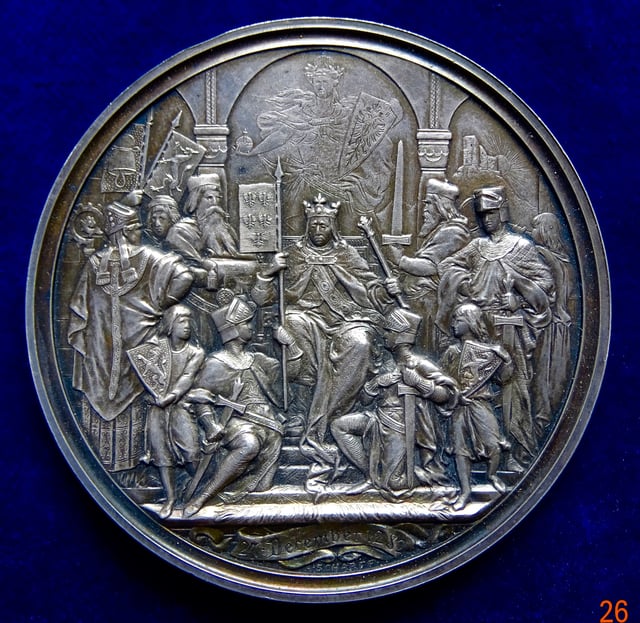
Augsburg 1282 Hoftag of King Rudolf I of Germany. Silver Medal by Scharff, obverse. 600th anniversary of the Habsburg Monarchy 1882.
The Habsburg family originated with the Habsburg Castle in modern Switzerland, and after 1279 came to rule in Austria. The Duchy of Austria was part of the elective Kingdom of Germany within the Holy Roman Empire. King Rudolf I of Germany of the Habsburg family assigned the Duchy of Austria to his sons at the Diet of Augsburg (1282), thus establishing the "Austrian hereditary lands". From that moment, the Habsburg dynasty was also known as the House of Austria. Between 1438 and 1806, with few exceptions, the Habsburg Archduke of Austria was elected Holy Roman Emperor.
The Habsburgs grew to European prominence as a result of the dynastic policy pursued by Maximilian I, Holy Roman Emperor. Maximilian I married Mary of Burgundy, thus bringing the Burgundian Netherlands into the Habsburg inheritance. Their son, Philip the Handsome, married Joanna the Mad of Spain (daughter of Ferdinand II of Aragon and Isabella of Castile). Charles V, Holy Roman Emperor (son of Philip and Joanna) inherited the Habsburg Netherlands in 1506, Habsburg Spain and its territories in 1516, and Habsburg Austria in 1519.
At this point, the Habsburg Empire was so vast that Charles V was constantly travelling throughout his dominions and therefore needed deputies and regents, such as Isabella of Portugal in Spain and Margaret of Austria in the Low Countries, to govern his various realms. At the Diet of Worms in 1521, Emperor Charles V came to terms with his younger brother Ferdinand. According to the Habsburg compact of Worms (1521), confirmed a year later in Brussels, Ferdinand was made Archduke as a regent of Charles V in the Austrian hereditary lands.[8][9]
Following the death of Louis II of Hungary and Bohemia in the Battle of Mohács against the Turks, Archduke Ferdinand (who was his brother-in-law by virtue of an adoption treaty signed by Maximilian and Louis at the First Congress of Vienna) was also elected the next King of Bohemia and Hungary in 1526.[10][7] Bohemia and Hungary became hereditary Habsburg domains only in the 17th century: Following victory in the Battle of White Mountain (1620) over the Bohemian rebels, Ferdinand II promulgated a Renewed Constitution (1627) that established hereditary succession over Bohemoa; and following the Battle of Mohács (1687), in which Leopold I reconquered almost all of Hungary from the Ottoman Turks, the emperor held a diet in Pressburg to establish hereditary succession in the Hungarian kingdom.
Charles V divided the House in 1556 by ceding Austria along with the Imperial crown to Ferdinand (as decided at the Imperial election, 1531) and the Spanish empire to his son Philip. The Spanish branch (which also held the Netherlands, the Kingdom of Portugal between 1580 and 1640, and the Mezzogiorno of Italy) went extinct in 1700. The Austrian branch (which also ruled the Holy Roman Empire, Hungary and Bohemia) was itself divided between different branches of the family from 1564 until 1665, but thereafter it remained a single personal union.
Austrian monarchy
Around 1700 the term monarchia austriaca came into use as a term of convenience for the Habsburg territories.[11]
Names
Habsburg Monarchy (German Habsburgermonarchie): This was an unofficial umbrella term, but very frequent, name even during that time. The entity had no official name. It was also known as "Danubian Monarchy" (German Donaumonarchie)
Austrian Empire (1804–1867): This was the official name. Note that the German version is Kaisertum Österreich, i.e. the English translation empire refers to a territory ruled by an emperor, not just to a "widespreading domain".
Austria-Hungary (1867–1918): This name was commonly used in the international relations, though the official name (translated to English) was Austro-Hungarian Monarchy.[12][13][14][15] An unofficial popular name was the Danubian Monarchy (German: Donaumonarchie) also often used was the term Doppel-Monarchie ("Dual Monarchy") meaning two states under one crowned ruler.
Crownlands or crown lands (Kronländer) (1849–1918): This is the name of all the individual parts of the Austrian Empire (1849–1867), and then of Austria-Hungary from 1867 on. The Kingdom of Hungary (more exactly the Lands of the Hungarian Crown) was not considered a "crownland" after the establishment of Austria-Hungary 1867, so that the "crownlands" became identical with what was called the Kingdoms and Lands represented in the Imperial Council (Die im Reichsrate vertretenen Königreiche und Länder).
The Hungarian parts of the Empire were called "Lands of the Crown of Saint Stephen" or "Lands of Holy (St.) Stephen's Crown" (Länder der Heiligen Stephans Krone). The Bohemian (Czech) Lands were called "Lands of the St. Wenceslaus' Crown" (Länder der Wenzels-Krone).
Names of some smaller territories:
Austrian lands (Österreichische Länder) or "Archduchies of Austria" (Erzherzogtümer von Österreich) – Lands up and below the Enns (ober und unter der Enns) (996–1918): This is the historical name of the parts of the Archduchy of Austria that became the present-day Republic of Austria (Republik Österreich) on 12 November 1918 (after Emperor Charles I had abdicated the throne). Modern day Austria is a semi-federal republic of nine states (Bundesländer) that are: Lower Austria, Upper Austria, Tyrol, Styria, Salzburg, Carinthia, Vorarlberg and Burgenland and the Capital of Vienna that is a state of its own. Burgenland came to Austria in 1921 from Hungary. Salzburg finally became Austrian in 1816 after the Napoleonic wars (before it was ruled by prince-archbishops of Salzburg as a sovereign territory).
- Vienna, Austria's capital became a state 1 January 1922, after being residence and capital of the Austrian Empire (Reichshaupt und Residenzstadt Wien) for the Habsburg monarchs for centuries. Upper and Lower Austria, historically, were split into "Austria above the Enns" and "Austria below the Enns" (the Enns river is the state-border between Upper- and Lower Austria). Upper Austria was enlarged after theTreaty of Teschen(1779) following the "War of the Bavarian Succession" by the so-calledInnviertel("InnQuarter"), formerly part of Bavaria.
Hereditary Lands (Erblande or Erbländer; mostly used Österreichische Erblande) or German Hereditary Lands (in the Austrian monarchy) or Austrian Hereditary Lands (Middle Ages – 1849/1918): In a narrower sense these were the "original" Habsburg Austrian territories, i.e. basically the Austrian lands and Carniola (not Galicia, Italian territories or the Austrian Netherlands). In a wider sense the Lands of the Bohemian Crown were also included in (from 1526; definitely from 1620/27) the Hereditary lands. The term was replaced by the term "Crownlands" (see above) in the 1849 March Constitution, but it was also used afterwards. The Erblande also included lots of small and smallest territories that were principalities, duchies or counties etc. some of them can namely be found in the reigning titles of the Habsburg monarchs like Graf (Earl/Count of) von Tyrol etc.
Territories
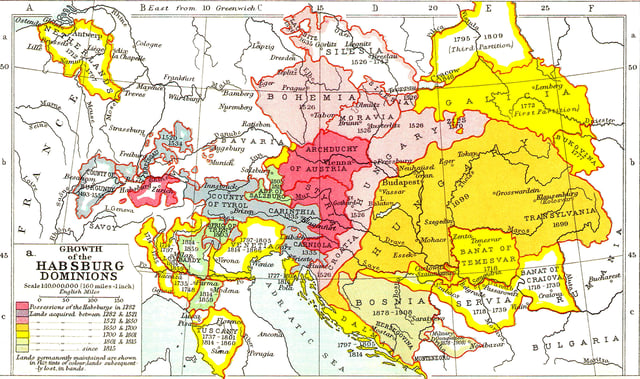
Growth of the Habsburg Monarchy in Central Europe
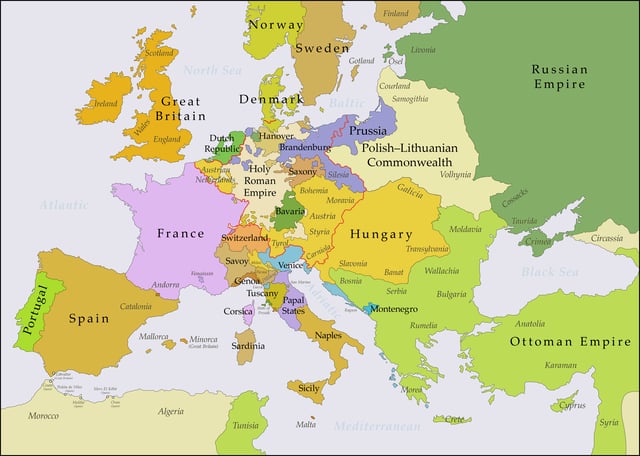
Habsburg Monarchy at the time of Joseph II's death in 1790. The red line marks the borders of the Holy Roman Empire.
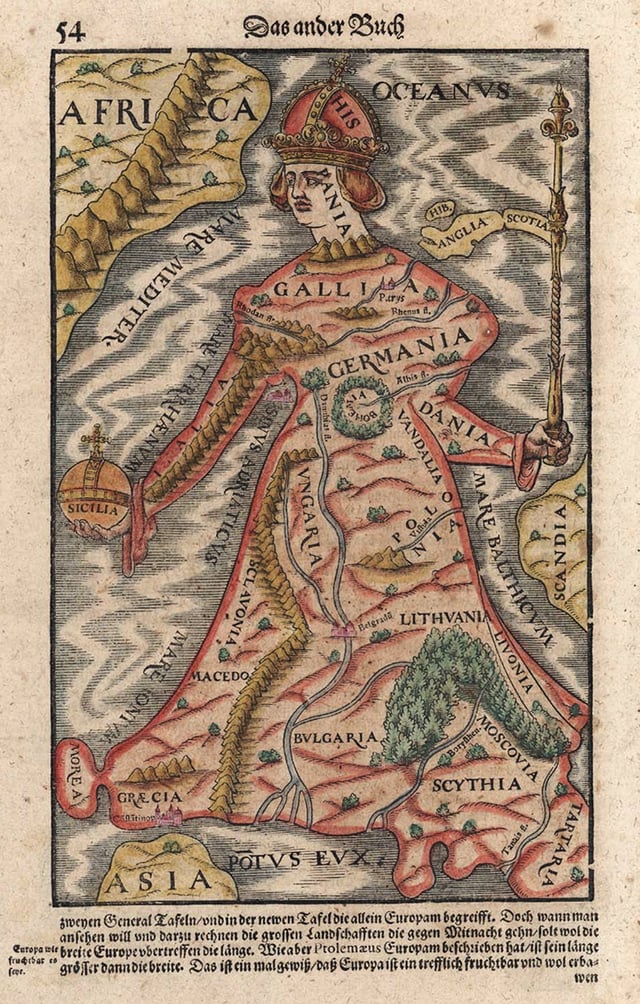
Europa regina, symbolizing a Habsburg-dominated Europe
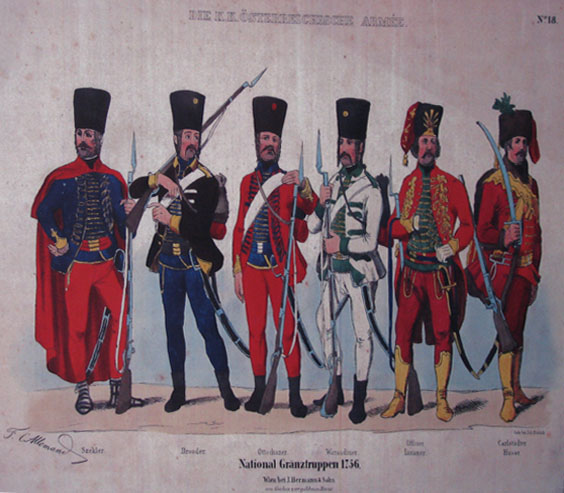
Soldiers of the Military Frontier against the incursions of the Ottoman Turks, 1756
The territories ruled of the Austrian monarchy changed over the centuries, but the core always consisted of four blocs:
The Hereditary Lands, which covered most of the modern states of Austria and Slovenia, as well as territories in northeastern Italy and (before 1797) southwestern Germany. To these were added in 1779 the Inn Quarter of Bavaria and in 1803 the Bishoprics of Trent and Brixen. The Napoleonic Wars caused disruptions where many parts of the Hereditary lands were lost, but all these, along with the former Archbishopric of Salzburg, which had previously been temporarily annexed between 1805 and 1809, were recovered at the peace in 1815, with the exception of the Vorlande. The Hereditary provinces included: Archduchy of Austria Upper Austria Lower Austria Inner Austria Duchy of Styria Duchy of Carinthia Duchy of Carniola The Adriatic port of Trieste Margraviate of Istria (although much of Istria was Venetian territory until 1797) Princely County of Gorizia and Gradisca County of Tyrol (although the Bishoprics of Trent and Brixen dominated what would become the South Tyrol before 1803) Further Austria, mostly ruled jointly with Tyrol. Vorarlberg (actually a collection of provinces, only united in the 19th century) The Vorlande, a group of territories in Breisgau and elsewhere in southwestern Germany lost in 1801 (although the Alsatian territories (Sundgau) which had formed a part of it had been lost as early as 1648) Grand Duchy of Salzburg (only after 1805)[[INLINE_IMAGE|//upload.wikimedia.org/wikipedia/commons/thumb/3/30/Maria_Theresa-coronation-1741-Pressburg-Hertz.jpg/220px-Maria_Theresa-coronation-1741-Pressburg-Hertz.jpg|//upload.wikimedia.org/wikipedia/commons/thumb/3/30/Maria_Theresa-coronation-1741-Pressburg-Hertz.jpg/330px-Maria_Theresa-coronation-1741-Pressburg-Hertz.jpg 1.5x, //upload.wikimedia.org/wikipedia/commons/thumb/3/30/Maria_Theresa-coronation-1741-Pressburg-Hertz.jpg/440px-Maria_Theresa-coronation-1741-Pressburg-Hertz.jpg 2x||h159|w220|thumbimage]] Coronation of Maria Theresa in Pressburg, Kingdom of Hungary, 1741
The Lands of the Bohemian Crown. The Bohemian Diet (Czech: zemský sněm) elected Ferdinand, later Holy Roman Emperor Ferdinand I, as king in 1526. Initially consisting of the five lands: Kingdom of Bohemia Margraviate of Moravia Silesia, Most of Silesia was conquered by Prussia in 1740–1742 and the remnants which stayed under Habsburg sovereignty were ruled as Duchy of Upper and Lower Silesia (Austrian Silesia). Lusatia, was ceded to Saxony in 1635. Upper Lusatia Lower Lusatia
The Kingdom of Hungary – two-thirds of the former territory that was administered by the medieval Kingdom of Hungary was conquered by the Ottoman Empire and the Princes of vassal Ottoman Transylvania, while the Habsburg administration was restricted to the western and northern territories of the former kingdom, which remained to be officially referred as the Kingdom of Hungary. In 1699, at the end of the Ottoman-Habsburg wars, one part of the territories that were administered by the former medieval Kingdom of Hungary came under Habsburg administration, with some other areas being picked up in 1718 (some of the territories that were part of medieval kingdom, notably those in the south of the Sava and Danube rivers, remained under Ottoman administration).
Kingdom of Croatia
Over the course of its history, other lands were, at times, under Austrian Habsburg rule (some of these territories were secundogenitures, i.e. ruled by other lines of Habsburg dynasty):
Serbia occupation (1686–1691)
Kingdom of Slavonia (1699–1868)
Grand Principality of Transylvania, between 1699 (Treaty of Karlowitz) and 1867 (Ausgleich)
Austrian Netherlands, consisting of most of modern Belgium and Luxembourg (1713–1792)
Duchy of Milan (1713–1797)
Kingdom of Naples (1713–1735)
Kingdom of Sardinia (1713–1720)
Kingdom of Serbia (1718–1739)
Banat of Temeswar (1718–1778)
Oltenia (1718–1739 de facto, 1716–1737), as Grand-Voivodate (sometimes designated as Valachia Caesarea)
Kingdom of Sicily (1720–1735)
Duchy of Parma (1735–1748)
Kingdom of Galicia and Lodomeria, in modern Poland and Ukraine (1772–1918)
Duchy of Bukovina (1774–1918)
Serbia occupation (1788–1792)
New Galicia, the Polish lands, including Kraków, taken in the Third Partition (1795–1809)
Venetia (1797–1805)
Kingdom of Dalmatia (1797–1805, 1814–1918)
Kingdom of Lombardy-Venetia (1814–1859)
Kraków, which was incorporated into Galicia (1846–1918)
Serbian Vojvodina (1848–1849) de facto entity, officially unrecognized
Voivodeship of Serbia and Banat of Temeschwar (1849–1860)
Kingdom of Croatia-Slavonia (1868–1918)
Sanjak of Novi Pazar occupation (1878–1913)
Bosnia and Herzegovina (1878–1918).
The boundaries of some of these territories varied over the period indicated, and others were ruled by a subordinate (secundogeniture) Habsburg line. The Habsburgs also held the title of Holy Roman Emperor between 1438 and 1740, and again from 1745 to 1806.
Characteristics
Within the early modern Habsburg Monarchy, each entity was governed according to its own particular customs. Until the mid 17th century, not all of the provinces were even necessarily ruled by the same person—junior members of the family often ruled portions of the Hereditary Lands as private apanages. Serious attempts at centralization began under Maria Theresa and especially her son Joseph II in the mid to late 18th century, but many of these were abandoned following large scale resistance to Joseph's more radical reform attempts, although a more cautious policy of centralization continued during the revolutionary period and the Metternichian period that followed.
Another attempt at centralization began in 1849 following the suppression of the various revolutions of 1848. For the first time, ministers tried to transform the monarchy into a centralized bureaucratic state ruled from Vienna. The Kingdom of Hungary was placed under martial law, being divided into a series of military districts, the centralized neo-absolutism tried to as well to nullify Hungary's constitution and Diet. Following the Habsburg defeats in the Wars of 1859 and 1866, these policies were step by step abandoned.
After experimentation in the early 1860s, the famous Austro-Hungarian Compromise of 1867 was arrived at, by which the so-called Dual Monarchy of Austria-Hungary was set up. In this system, the Kingdom of Hungary ("Lands of the Holy Hungarian Crown of St. Stephen.") was an equal sovereign with only a personal union and a joint foreign and military policy connecting it to the other Habsburg lands. Although the non-Hungarian Habsburg lands were referred to as "Austria", received their own central parliament (the Reichsrat, or Imperial Council) and ministries, as their official name – the "Kingdoms and Lands Represented in the Imperial Council". When Bosnia and Herzegovina was annexed (after a long period of occupation and administration), it was not incorporated into either half of the monarchy. Instead, it was governed by the joint Ministry of Finance.
Austria-Hungary collapsed under the weight of the various unsolved ethnic problems that came to a head with its defeat in World War I. After its dissolution, the new republics of Austria (the German-Austrian territories of the Hereditary lands) and the First Hungarian Republic were created. In the peace settlement that followed, significant territories were ceded to Romania and Italy and the remainder of the monarchy's territory was shared out among the new states of Poland, Kingdom of Serbs, Croats and Slovenes (later Yugoslavia), and Czechoslovakia.
Other lines
A junior line ruled over the Grand Duchy of Tuscany between 1765 and 1801, and again from 1814 to 1859. While exiled from Tuscany, this line ruled at Salzburg from 1803 to 1805, and in Grand Duchy of Würzburg from 1805 to 1814. Another line ruled the Duchy of Modena from 1814 to 1859, while Empress Marie Louise, Napoleon's second wife and the daughter of Austrian Emperor Francis, ruled over the Duchy of Parma between 1814 and 1847. Also, the Second Mexican Empire, from 1863 to 1867, was headed by Maximilian I of Mexico, the brother of Emperor Franz Josef of Austria.
Rulers 1508–1918
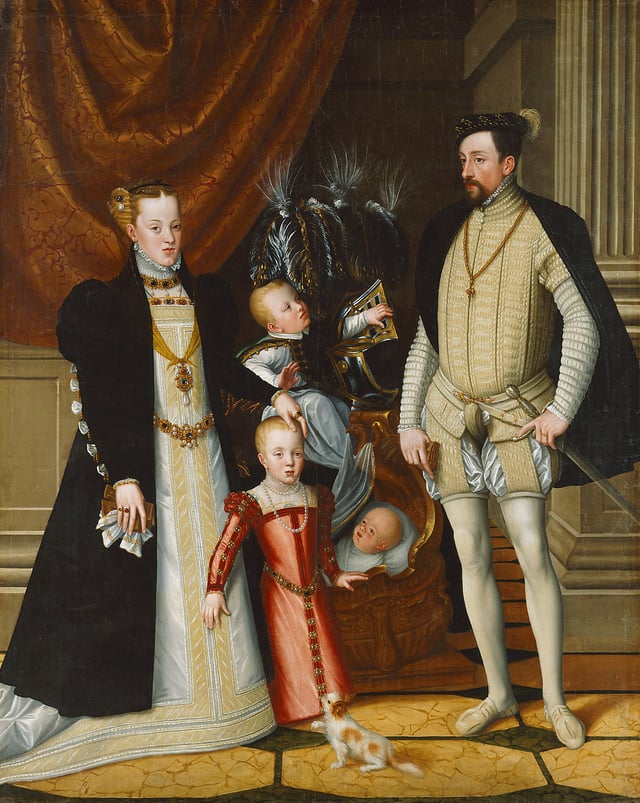
Maximilian II, Holy Roman Emperor and his wife Infanta Maria of Spain with their children
The so-called "Habsburg monarchs" or "Habsburg emperors" held many different titles and ruled each kingdom with a different name and position.
Maximilian I 1508–1519
Charles V 1519–1556
Ferdinand I 1556–1564
Maximilian II 1564–1576
Rudolf II 1576–1612
Matthias 1612–1619
Ferdinand II 1619–1637
Ferdinand III 1637–1657
Leopold I 1657–1705
Joseph I 1705–1711
Charles VI 1711–1740
Maria Theresa 1740–1780 (German: Maria Theresia)
Habsburg-Lorraine
Joseph II 1780–1790 known as "the great Reformer"
Leopold II 1790–1792 from 1765 to 1790 "Grandduke of Tuscany"
Francis II 1792–1835 correctly written "Franz" (became Emperor Francis I of Austria in 1804, at which point numbering starts anew)
Ferdinand I 1835–1848 known as "Ferdinand the Good" German: "Ferdinand der Gütige"
Francis Joseph I 1848–1916 Brother of Emperor Maximilian of Mexico (ruled 1864–1867)
Charles I 1916–1918 last reigning Monarch of Austria-Hungary
Otto von Habsburg-Lothringen or sometimes called Otto von Österreich Crown Prince of Austria to be found as Otto von Habsburg
Family tree
Habsburg family tree
In literature
The most famous memoir on the decline of the Habsburg Empire is Stefan Zweig's The World of Yesterday.[16]
